梵蒂冈,拉丁语中意为“先知之地”。早在西元4世纪,罗马皇帝君士坦丁就在罗马城西北角耶稣门徒圣伯多禄(圣彼得)殉难处建立了君士坦丁大教堂以示纪念;到了15至16世纪,君士坦丁大教堂被改建成如今的圣伯多禄大殿,成为天主教会举行重大仪式的场所;公元756年,法兰克王国国王丕平把罗马城及其周围区域送给教宗(教会史上称为“丕平献土”),后来就以此成立了半世俗政体型态的“教宗国”,范围广及意大利半岛中部的大部分地区。
19世纪,欧洲的民族主义兴起,意大利的民族统一运动使圣座于意大利的领土愈来愈少,半岛北方的萨丁尼亚王国成为意大利统一运动的领导者之后,更主导成立了意大利王国。身为教宗国首府的罗马城面临统一在即,法兰西第二帝国皇帝拿破仑三世以身为“教会的保护者”的名义出兵保护罗马城。1870年普法战争爆发,拿破仑三世把驻在罗马的军队调回本国,使得意大利王国的军队得以顺利开进罗马城,意大利的统一正式完成,而教宗被迫退居罗马城西北角的梵蒂冈宫中;之后历代教宗均敌视新的意大利王国,甚至不准信徒参与意大利王国的公职。
1929年2月11日,意大利首相墨索里尼掌握意大利政权后与教宗庇护十一世签订了《拉特兰条约》,意大利承认圣座为主权国家,其主权属教宗,其领土位于梵蒂冈城,称为梵蒂冈城国,为中立国,其国土神圣不可侵犯。此条约正式解决了圣座与意大利政府间多年的纠纷。第二次世界大战期间,梵蒂冈仍按照《拉特兰协议》,保持中立,当时教宗为庇护十二世。
梵蒂冈城本身就是一件伟大的文化瑰宝,城内的建筑如圣伯多禄大殿、西斯廷礼拜堂等都是世界上重要的建筑作品,包含了波提切利、贝尔尼尼、拉斐尔和米开朗基罗等人的作品。梵蒂冈也拥有一个馆藏丰富的图书馆,以及一个博物馆,专门收藏具有历史、科学与文化价值的艺术品。
梵蒂冈的日常生活具有浓厚的宗教色彩,每当星期日,天主教徒聚集在圣伯多禄广场,中午12点,随着教堂钟声响起,教宗在圣伯多禄大教堂楼顶正中窗口出现,向教徒们发表演说,梵蒂冈的瑞士卫队每年5月6日在圣达马索庭院(意大利语:Cortile di San Damaso)内举行宣誓仪式,诵念5个多世纪来一直不变的誓词,祈求天主保佑自己圆满完成任务,效忠教宗可以献出自己的生命。
圣伯多禄大殿(拉丁语:Basilica Sancti Petri,意大利语:Basilica di San Pietro in Vaticano),亦名圣伯多禄大教堂、梵蒂冈大殿、又译作圣彼得大教堂,是位于梵蒂冈的一座天主教宗座圣殿,建于1506年至1626年,可能是世界最大的教堂,也是天主教会最重要的圣地之一。其占地23,000平方米,可容纳超过六万人。教堂中央是直径42米的穹窿,顶高约138米,前面有两重用柱廊围绕的巴洛克式广场。意大利文艺复兴时期的建筑师与艺术家多纳托·伯拉孟特、拉斐尔、米开朗基罗和小安东尼奥·达·桑加罗等都曾参与设计。广场的设计人是贝尼尼。堂内保存有欧洲文艺复兴时期许多艺术家如米开朗基罗、拉斐尔等的壁画与雕刻。
地位
圣伯多禄大殿是罗马的四座特级宗座圣殿之一(圣若望拉特朗大殿、圣伯多禄大殿、圣母大殿和城外圣保禄大殿),它也是梵蒂冈城中最主要的建筑物。圣伯多禄大殿的穹顶构成罗马城天际线的主要标志。圣伯多禄大殿常被外界误解是象征教宗驻地的“教宗宝座”所在,但教宗宝座其实是在圣若望拉特朗大殿——其亦为天主教罗马教区的主教座堂。虽然如此,今日许多圣座礼仪与瞻礼还是在圣伯多禄大殿举行,主要是因为这里离教宗官邸较近、空间也较大、而且位于拥有独立主权的梵蒂冈城之内。
圣彼得广场



圣彼得大教堂 Saint Peter's Basilica


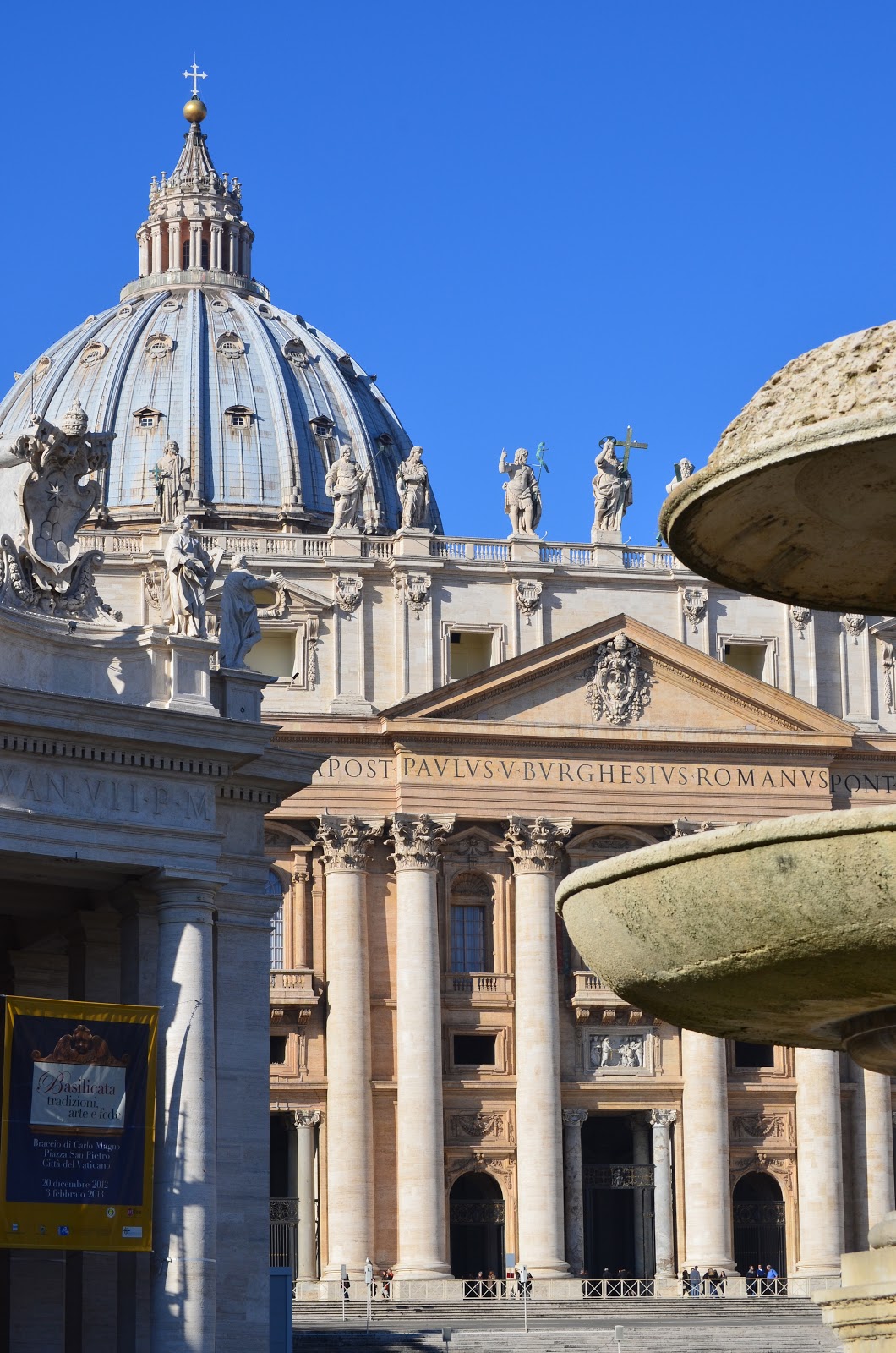
大殿正门前的圣彼得雕像

大殿正门前的圣保罗雕像Apostle St Paul's Statue


The Grave of Pope Gregory XIII


The Holy Door is opened only for great celebrations.
Narthex and portals
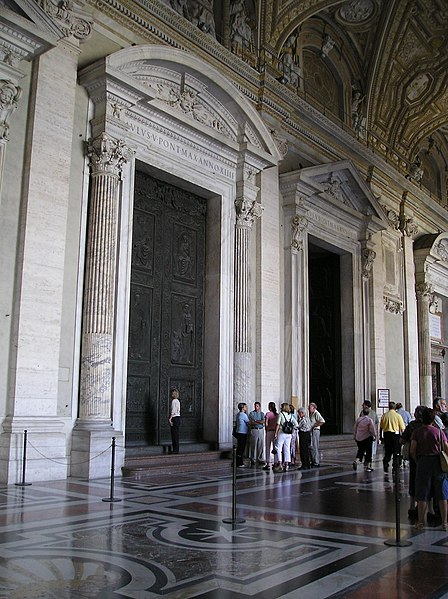
The altar with Bernini's baldacchino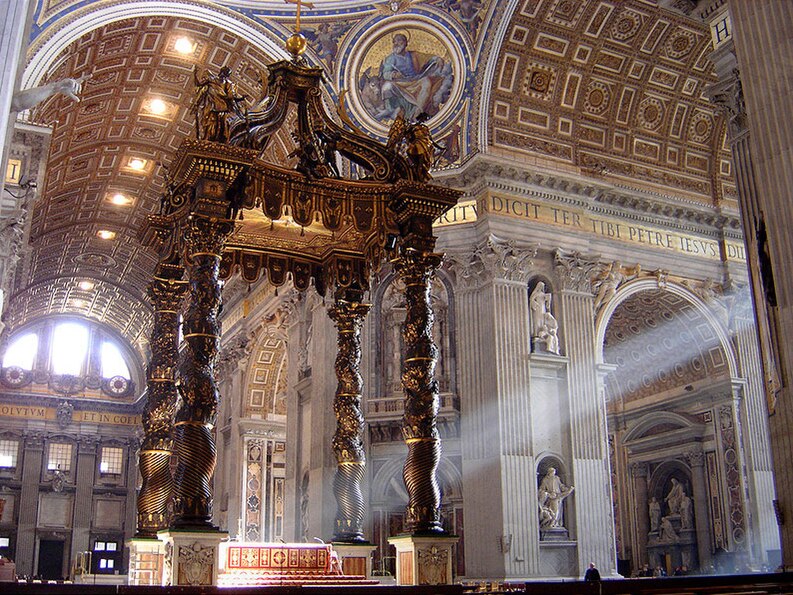






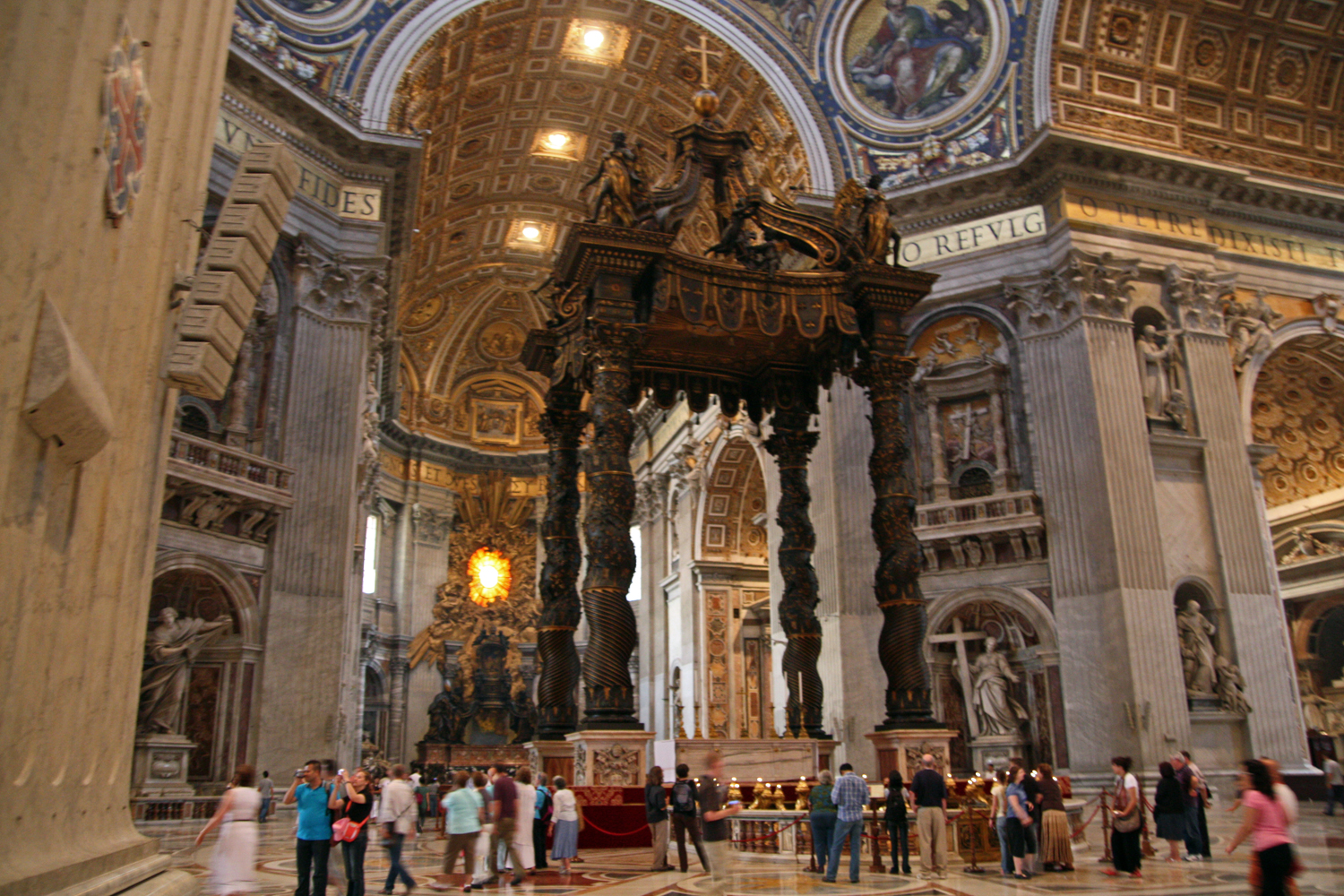
Bernini's "Cathedra Petri" and "Gloria"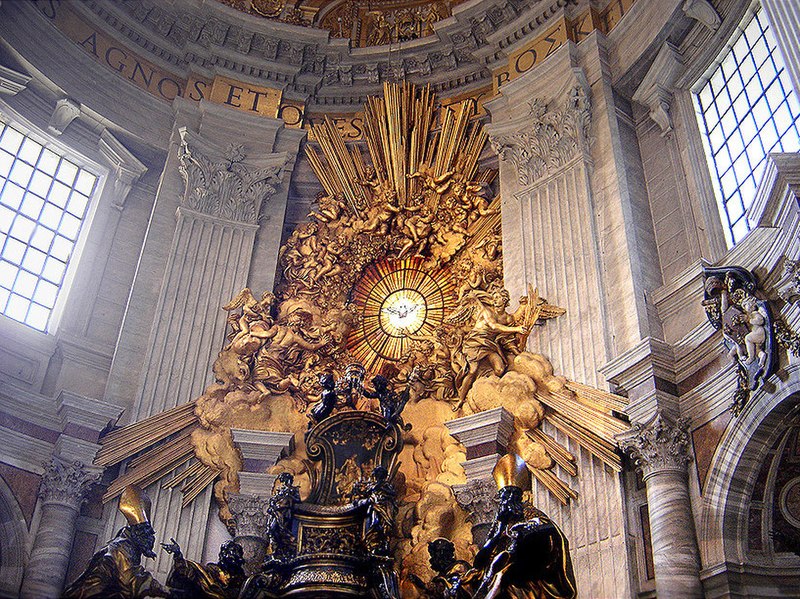

The dome was brought to completion by Giacomo della Porta and Fontana.



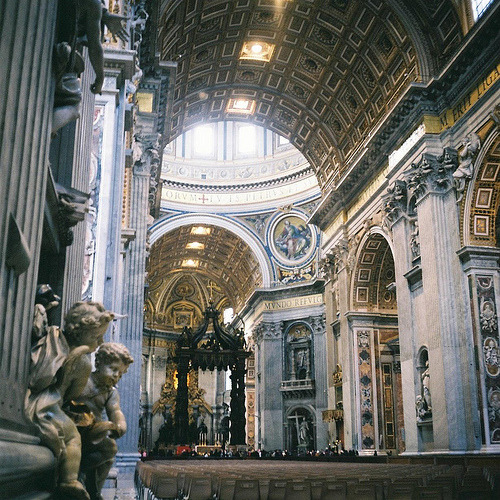

Private Chapel of the Canons of St. Peter's Basilica located just off the Canons sacristy
The Pietà (1498–1499) is a masterpiece of Renaissance sculpture by Michelangelo Buonarroti, housed in St. Peter's Basilica in Vatican City. It is the first of a number of works of the same theme by the artist. The statue was commissioned for the French cardinal Jean de Billheres, who was a representative in Rome. The sculpture, in Carrara marble,
was made for the cardinal's funeral monument, but was moved to its
current location, the first chapel on the right as one enters the
basilica, in the 18th century. It is the only piece Michelangelo ever
signed.
圣母怜子像(米开朗基罗)

The bronze statue of Saint Peter, attributed to Arnolfo di Cambio.

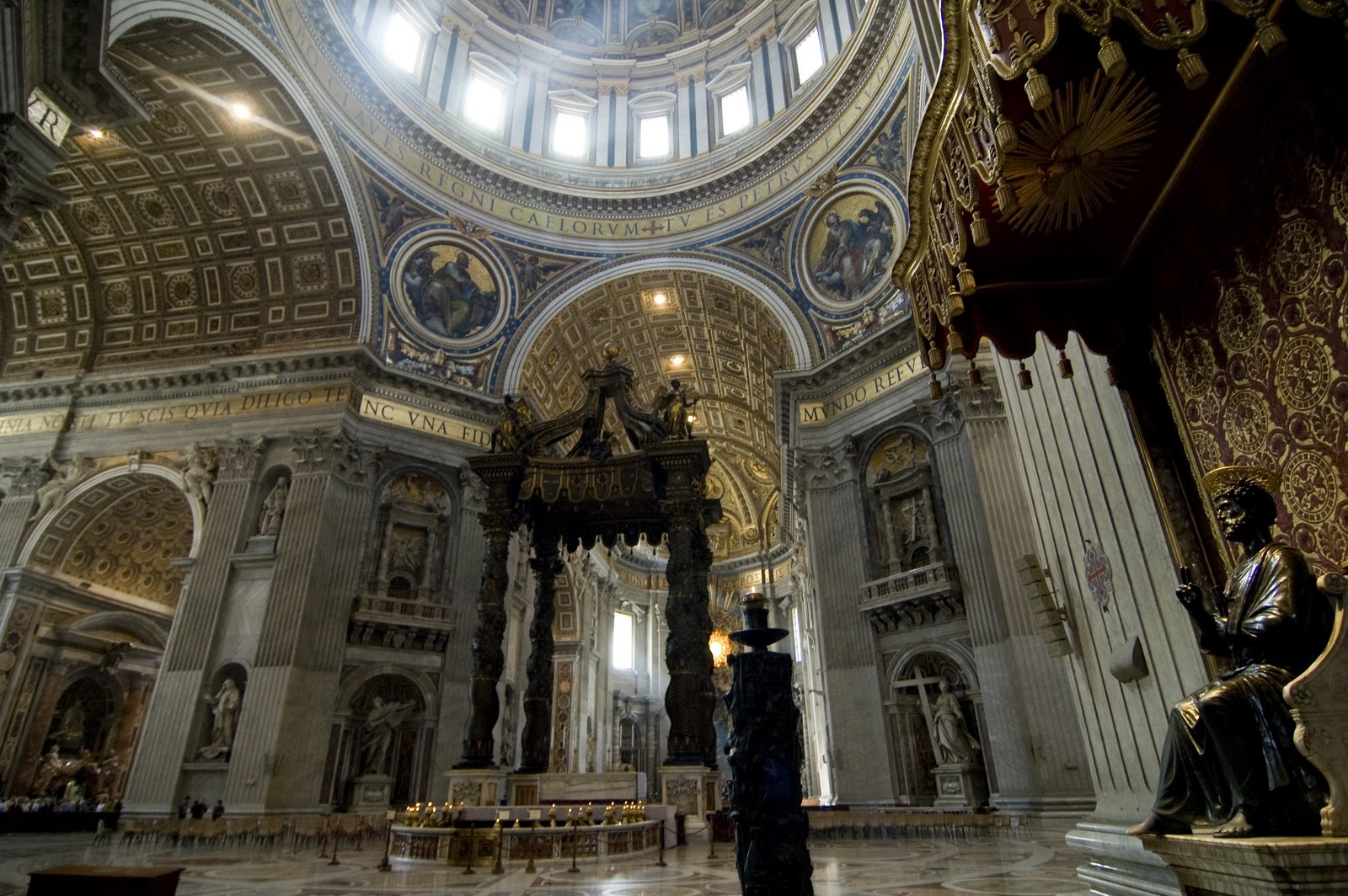



Truth, by Bernini. Her big toe is pierced by a thorn from Britain.
Statues in the piers of the dome
Saint Helena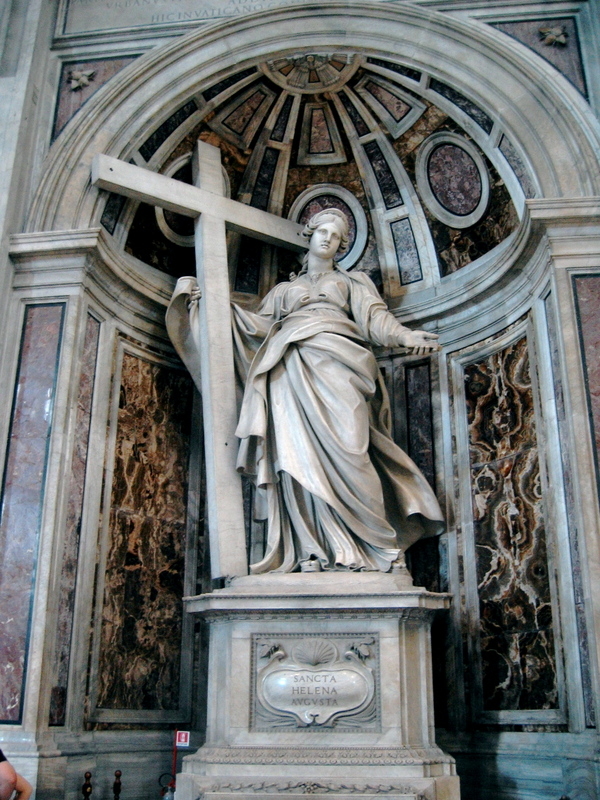
St Longinus
St Andrew
St Veronica
The Altar of Falsehood, on the left (south) side of the southeast pier
near the left transept.
This mosaic dates from 1725-27 and is based on a
painting by Roncalli, 1599-1604.
It depicts a scene from Acts 5:1-11,
where the couple Ananias and Sapphira lied to St. Peter and were struck
dead.


It was for this altar that Caravaggio painted St. Anne with the Virgin and Child. The painting was placed over the altar on April 14, 1606, but was removed two days later.
It was for this altar that the first mosaic altarpiece in the new basilica was made, unveiled September 29, 1628, the feast of St. Michael and the anniversary of Urban VIII's papacy.
The mosaic was replaced by another in 1758, after Guido Reni's Saint Michael in S. Maria della Concezione.

Monument to Pope Benedict XV


The Chapel of Saint Sebastian,painting
by Domenichino, 1628-31
mosaic by Cristofari, 1730-36.
Pier Paolo Cristofari, who executed Domenichino's painting into mosaic, was the Director of the Vatican Mosaic Studio from 1743-1755. He is responsible for many of the altarpieces in St. Peter's.
Under the altar
lies the remains of Blessed Innocent XI (1676-1689).

Altar of St. Thomas, under a mosaic showing the scene of his disbelief.
Under the altar are relics of Pope St. Boniface IV, who consecrated the Pantheon for Christian worship.


The altar of St Jerome closes the right-side aisle, as it is set at the
back of the pier of St Longinus. Since 2nd June 2001 it had been dedicated
to the Blessed John XXIII. Over it is the altarpiece with the Last Communion
of St Jerome, a mosaic copy realized in 1730 after the famous painting
by Domenichino, nowadays kept in the Pinacoteca Vaticana. Beneath the
altar is the body of Blessed Pope John XXIII, here transferred on 4th
June 2001. The four gilt bronze bas-reliefs were made by Novello Finotti,
who represented two moments in John's pontificate: the II Vatican Council
and UT UNUM SINT and two encyclicals MATER ET MAGISTRA and PACEM IN TERRIS.
Altar and tomb of Pope St. Gregory the Great
The subject of the altarpiece is St. Basil Celebrating Mass in the presence of the Arian Emperor Valens.
St. Basil is so involved in his devotion at Mass during the Feast of the Epiphany in 372 that he does not notice Emperor Valentius enter with his retinue.
The Chapel takes its name from the fact that the Liturgy of the Hours are celebrated here.
The mosaic
commemorates the Definition of Mary's Immaculate Conception.
(Dec. 8, 1854).
Its design was traditionally attributed to Giacomo della Porta (1540-1602),
but today it is thought to be the work of Carlo Maderno. It owes its name
to the fact that the canons of the basilica used to celebrate the Liturgy
of the Hours here as a choir. The gate of the chapel, usually closed,
is of exquisite workmanship.
The altarpiece, by Pietro Bianchi (1694-1740), shows the Virgin Immaculate in glory surrounded by angels and venerated by Sts. Francis of Assisi, Anthony of Padua, John Chrysostom. On December 8, 1854, on the occasion of the proclamation of the Dogma of the Immaculate Conception, Pius IX crowned the image of Mary. To mark the 50th anniversary of the Dogma, St. Pius X added a second crown, consisting of twelve stars, gleaming with twelve brilliants, donated by various nations.
Beneath the altar are the remains of St. John Chrysostom and relics of St. Francis and St. Anthony. The paschal candle stands on a black and white marble column with a porphyry base, in accordance with Paul VI's wishes.
The vault of the chapel, divided by four Corinthian pilasters, is decorated with fine gilded stucco ornaments on a white background, showing the Creation, the Crossing of the Red Sea, the Baptism of Jesus. In the dome are the Vision of the angels and the Elect of the Apocalypse. In the vault are shown: Habakuk and the angel, Daniel in the lions' den, David, Jonah inside the whale. In the lunettes, Deborah and Barak, Judith with Holofern's head, Moses and Aaron, Ozaziah and Uzziah and Jeremiah.
The dark wooden choir against the walls has a triple row of stalls, adorned with magnificent bas-reliefs and decorations; above it on each side are two historical organs.


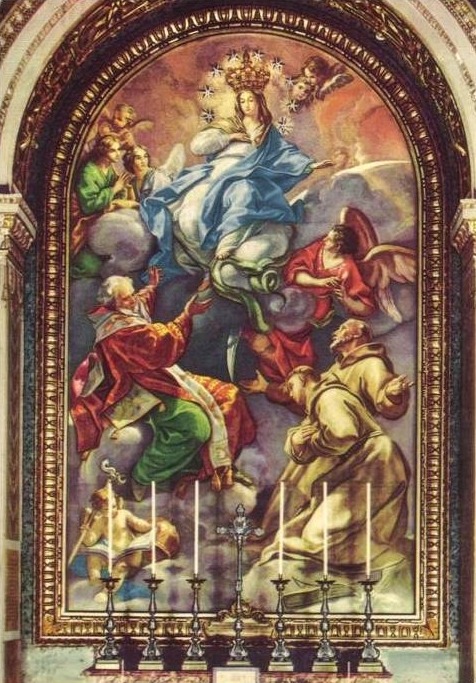
The mosaic altarpiece is the Presentation of the Virgin Mary in the Temple by her parents.
Below the altar is the body of St. Pius X (1904-1914), the last pope to be canonized.

"Monument to the Royal Stuarts" by Antonio
Canova, St Peter's Cathedral, Roma. Shows King James III The Old
Pretender (middle), his two sons Charles Edward (left) and Henry
Benedict (right).
Henry Benedict Stuart (11 March 1725 – 13 July 1807) was a Roman Catholic Cardinal, as well as the fourth and final Jacobite heir to publicly claim the thrones of England, Scotland, and Ireland. Unlike his father, James Francis Edward Stuart, and brother, Charles Edward Stuart, Henry made no effort to seize the throne. After Charles's death in January 1788 the Papacy did not recognise Henry as the lawful ruler of England, Scotland and Ireland, but referred to him as the Cardinal Duke of York.
He spent his life in the Papal States and had a long career in the clergy of the Roman Catholic Church, rising to become the Dean of the College of Cardinals and Cardinal-Bishop of Ostia and Velletri. At the time of his death he was (and still is) one of the longest serving Cardinals in the Church's history.
In his youth, Henry's father made him Duke of York (in the Jacobite peerage), and it was by this title that he was best known. Upon the death of his brother in 1788 Henry became known by Jacobites, and within his personal entourage, as Henry IX of England, although publicly he referred to himself as Cardinal-Duke of York nuncupatus.


Baptismal Font of the basilica

Altar of Transfiguration, painting
by Raphael, 1520


The Niccoline Chapel (Italian: Cappella Niccolina) is a chapel in the Apostolic Palace in Vatican City. It is especially notable for its fresco paintings by Fra Angelico (1447–1451)
Artist: Fra Angelico
Start Date: 1447
Completion Date:1449

St Peter Consacrates St Lawrence as Deacon,between and fresco



Fra Angelico, “Saint Lawrence receives the treasures of the Church”, a fresco (paint on wet plaster), c.1447


Saint Stephen (Koine Greek: Στέφανος, Stephanos; sometimes spelled "Stephan"), the first martyr of Christianity, was, according to the Acts of the Apostles, a deacon in the early church at Jerusalem who aroused the enmity of members of various synagogues by his teachings. Accused of blasphemy, at his trial he made a long speech fiercely denouncing the Jewish authorities who were sitting in judgement on him and was stoned to death. His martyrdom was witnessed by Saul of Tarsus (later renamed Paul), a Pharisee who would later convert to Christianity and become an Apostle.
The Stoning of Stephen

Thus castigated, the account is that the crowd could contain their anger no longer. However Stephen, seemingly now oblivious to them, looked up and cried "Look! I see heaven open and the Son of Man standing on the right hand of God!"[Acts 7:55]
To the Sanhedrin, this claim that the recently executed Jesus was
standing by the side of God (not sitting, as he is usually described in
New Testament texts) was such intense blasphemy that they covered their
ears so as not to hear it.[Acts 7:55]
They rushed upon Stephen, drove him outside the city to the place
appointed, and stoned him. At this time Jewish law permitted the death
penalty by stoning for blasphemy. The witnesses, whose duty it was to throw the first stones, laid their coats down so as to be able to do this, at the feet of a "young man named Saul",later to be known as Paul the Apostle. Stephen prayed that the Lord would receive his spirit and his killers be forgiven, sank to his knees, and "fell asleep".[Acts 7:58-60] Saul "approved of their killing him".[Acts 8:1]











四间拉斐尔客房(Stanze di Raffaello)是梵蒂冈宫内的一组客房,教宗住所的公共部分。它们以拉斐尔及其工作室创作的壁画著称。它们连同西斯廷礼拜堂内米开朗基罗的天顶画,构成标志罗马文艺复兴的盛大的壁画系列。
康斯坦丁大厅
四个房间中最大的一个是康斯坦丁大厅(Sala di Costantino)。这些壁画创作于教宗儒略时期,那时,拉斐尔本人已经去世。这个房间的主题是基督教战胜了异教。壁画通过罗马皇帝康斯坦丁一世的生平反映这场斗争。这些壁画是朱利奥·罗马诺、吉昂弗朗斯科·班尼和若弗琳诺·迪·库里的作品。由于这些壁画不是出自大师本人之手,它们不及相邻房间的作品出名。出于一种奉承的悠久的传统,拉斐尔的助手在画中将教宗西尔维斯特的面容描绘成当时的教宗克萊孟七世的面容。
十字架显圣
壁画《十字架显圣》描绘当康斯坦丁出征他的对手马克森提乌斯时,巨大的十字架向他显现的传奇故事。在天空中出现十字架的异象,旁边是希腊文“Εν τούτω νίκα”(藉此記號,你必征服)。

米尔维安大桥战役
《米尔维安大桥战役》朱利奥·罗马诺表现的是发生于312年10月28日的米尔维安大桥战役。
康士坦丁的捐赠
《康斯坦丁的捐赠》的灵感来自于著名的康斯坦丁的捐赠,这份伪造文件内容称羅馬皇帝康士坦丁一世將羅馬一帶的土地贈送給教宗。

康斯坦丁的洗礼
最后一幅画,《康斯坦丁的洗礼》,最有可能是吉昂弗朗斯科·班尼所画,表现了这位皇帝在临终前的情形。

伊利奥多罗厅
从东向西的第二个房间,是伊利奥多罗厅(Stanza di Eliodoro)。这里的壁画绘于1511年到1514年,房间也得名于其中的一幅画。这个私人房间的主题是基督在天上保护教会。 四幅壁画分别是:《伊里奥多罗被逐出圣殿》、《保尔塞那的弥撒》、《良一世与阿提拉的会议》和《解救圣伯多禄》。其中前两幅壁画, 拉斐尔将他的赞助人教宗儒略二世画成了参与者或观察者;第三幅绘于儒略死后,包括他的继任者良十世的肖像。
与签字厅相比,拉斐尔的风格在此有所改变。与教宗图书馆的静态图像不同,取而代之的是戏剧性的叙述描绘,他的做法是,最大限度地提高壁画的表现效 果。他描绘较少,较大的人物,因此他们的行为和情绪 对观众有更直接的影响,他使用舞台灯光效果来突出某些人物,和加剧紧张局势。
伊里奥多罗被逐出圣殿
拉斐尔的《伊里奥多罗被逐出圣殿》取材自马加比二书(3:21-28) 关于伊里奥多罗,受命抢夺保存在耶路撒冷圣殿的
珍宝,但是受到阻止,因为天使答应圣殿祭司的祷告,鞭打入侵者,一个天使般的骑手从圣殿将其追赶。比起签字厅内拉斐尔的早期壁画,这幅画具有更多的戏剧
性。虽然焦点是正在祷告的祭司这个静止的人物,伊里奥多罗和天使向前冲入空中,似乎要飞出画面。在左侧,儒略二世由瑞士卫队抬在椅子上,目击了这一事件。
在这里也是指儒略防止世俗领袖篡夺教廷领土的斗争。

保尔塞那的弥撒
《保尔塞那的弥撒》描绘了一位波希米亚牧师故事,他在1263年在弥撒过程中看到面包开始流血,于是停止了对化质说教义的
怀疑。被血染红的布成为圣物,在奥尔维耶多附近小镇;儒略二世访问奥尔维耶多,并在1506年为此圣物祈祷。这位教宗被描绘成一个弥撒的参与者和奇迹的见
证者;他跪在祭台的右边,Curia 的成员站在他身后。拉斐尔从事件中的参与程度来区分“真正的”13世纪的见证人与教宗同时代的见证人。

良一世与阿提拉的会议
《良一世与阿提拉的会议》描绘了历史上有名的良一世和阿提拉的会议,包括圣伯多禄和圣保禄在天空持剑的图像。拉斐尔一个充
分发展的绘图显示他计划将教宗描绘成儒略的面容 - 在背景中;当良十世成为教宗时 -
他必须鼓励艺术家将教宗描绘在前方中央的位置,并使用自己的肖像。

解救圣伯多禄
《解救圣伯多禄》分为三段,描绘了使徒行传十二章所记载的圣伯多禄被一位天使解救出狱的故事。它象征着基督牧者的力量逃脱
人类的限制。儒略二世在升任教宗之前担任枢机主教时,领衔教堂就在圣伯多禄锁链堂,所以这幅画既是概指教宗制,又是特指儒略。这幅壁画是一种对光线的研
究:天然的的月光,人工的火炬光,以及上帝提供的天使光。当然,后者的光优于其他两种光。

签字厅
首先用拉斐尔壁画装饰的是签字厅(Stanza della segnatura)。它曾是儒略二世的图书馆,宗座圣玺最高法院曾设于此处。艺术家的概念是,带进古代精神与基督教的和谐,以及反映儒略二世的图书馆的内容:神学、哲学、法学和诗歌四大主题。这个房间的主题是世俗智慧与属灵智慧的和谐,以及文艺复兴人文主义者感知的基督教与希腊哲学之间的和谐。智慧的主题很适合这个房间,因为此处曾是宗座圣玺最高法院的会议室,大多数重要的教宗文件都是在此签字盖章。
圣体的辩论
拉斐尔的第一幅壁画《圣体的辩论》创作于1508年或1509年。在这幅作品中,拉斐尔描绘的教会的形象,跨越天与地。

雅典学院
1509年底,拉斐尔开始在《圣体的辩论》对面的墙上,创作第二幅壁画《雅典学院》。整个房间解释为从古典哲学到真正的宗教,以及从前基督教世界到基督教的运动。这也许是拉斐尔最著名的一幅壁画。

帕那苏斯山
拉斐尔在150年底或1510年初开始创作第三幅壁画《帕那苏斯山》。在古代神话中,那里是阿波罗和缪斯女神居住的地方,以及诗歌的家乡。在壁画中,阿波罗和缪斯女神被古代和拉斐尔时代的诗人所环绕。

三德像
第四幅壁画《三德像》绘于1511年。所谓“三德”,是指刚毅、审慎和节制。

博尔戈火灾厅
博尔戈火灾厅(Stanza dell'incendio del Borgo)得名于壁画《博尔戈火灾》,这幅画描绘良四世十字架的记号扑灭罗马博尔戈区(靠近梵蒂冈)的熊熊大火。这个房间准备作为儒勒的继任者良十世的音乐室。壁画描绘了教宗良三世和良四世的生平事迹。房间里另外三幅壁画是《良三世的誓言》、《查理大帝加冕》和《沃斯提亚战役》。《博尔戈火灾》是由拉斐尔设计构图,但是由他的助手执行。另外三幅画没有他的指导。
良三世的誓言
800年12月23日,教宗良三世面对他的前任教宗哈德良一世的侄子对他提出的指控进行宣誓。这一事件在壁画《良三世的誓言》中得到展现。
查理大帝加冕
《查理大帝加冕》表现查理大帝在800年圣诞节加冕成为神圣罗马皇帝的情景。

博尔戈火灾
《博尔戈火灾》描绘了847年在罗马博尔戈区发生的一次火灾。根据天主教会传统,教宗良四世用他的祝福控制了火势。

沃斯提亚战役
《沃斯提亚战役》的灵感来自于良四世于849年在沃斯提亚战役中战胜了撒拉逊人。



